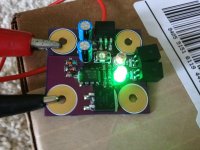dmwahl
10 kW
circuit said:How is this one different from numerous other TL431 based "BMS"?
The monitoring part of the circuit (the TL431 part) isn't much different, in fact it's very similar to the reference design in TI's datasheet (http://www.ti.com/lit/ds/symlink/tl431.pdf, figure 24). The PWM portion of the BMS that turns on when balancing starts is the part I haven't seen in other BMSs. I actually build a standalone version of it to test the concept, boards came in yesterday and I got one built up (see attachment). Works beautifully, although my soldering skills leave something to be desired.
I mostly just thought it would be a fun project to do on my own



